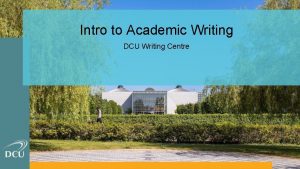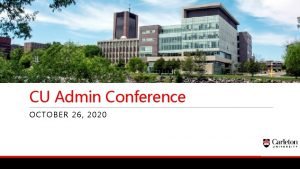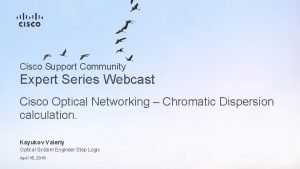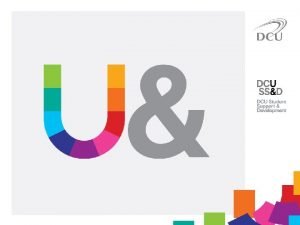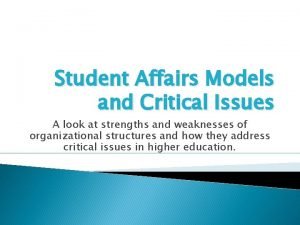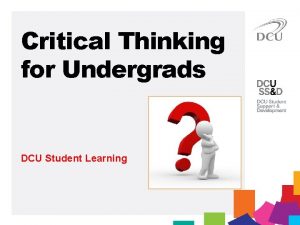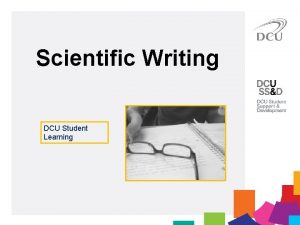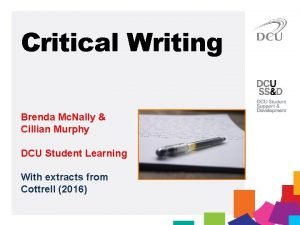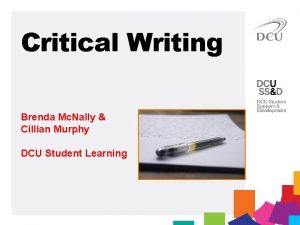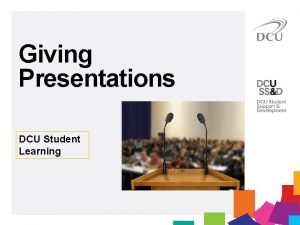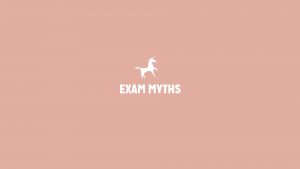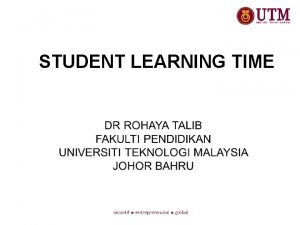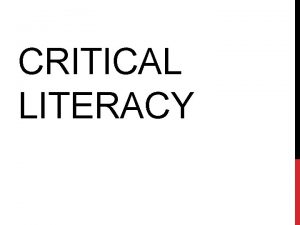Critical Writing for MA Students DCU Student Learning




















- Slides: 20

Critical Writing for MA Students DCU Student Learning

Learning Aims 1. Critical Thinking at MA Level 2. What’s An Argument? 3. Critical Reading 4. Critical Writing 5. Workshop Exercises/Discussion

Critical Thinking involves • Developing a questioning attitude towards what you read • Looking for alternatives in what you read: Asking why/how something happens Asking why something is important Asking …… ? ? In order to engage in analysis of what you read and to write critically

Being Critical In Assignments - Show understanding of topic (ie) relevant reading, summarising main points, identifying key information - Apply knowledge (ie) selecting only relevant information - Original ideas (ie) your analysis of topic - Valid argument (ie) your position on topic, supported by evidence

What’s an Argument? • An essay usually requires an argument • You are being asked to present a position on an issue and support this position with reasons (evidence)

Is It An Argument? • Genetic Engineering really worries me. I don’t think it should be allowed • That doesn’t convince me. I think genetic engineering is really exciting

Is it an argument? • Genetic engineering should be curtailed because there has not been sufficient research into what happens when new varieties are created without natural predators to hold them in check.

Critical Reading… • • • Is a technique for discovering information and ideas in a text Involves reading with a purpose: to fully understand the merits and limitations of what a text says and does Examines what a text means in order to draw a conclusion … Refers to careful, active, reflective, analytic reading

Workshop Exercise… Mary had a little lamb, Its fleece was white as snow, and everywhere that Mary went The lamb was sure to go

Restatement … • A restatement would simply talk about Mary and the lamb “Mary had a lamb that followed her everywhere” When is this kind of writing useful?

Description…. . • A description would talk about the story within the fairy tale “The nursery rhyme describes a pet that followed its mistress everywhere” When is this kind of writing useful?

Evaluation…. . • Evaluation involves deconstructing ideas in texts in order to come to your own conclusion about the text • (eg) the nursery rhyme conveys the idea of innocent devotion When is this kind of writing useful?

Sample answer Discuss/Critically evaluate themes …. . The nursery rhyme ‘Mary had a little lamb’ conveys theme of ‘innocent devotion’ through its narrative structure, use of language and style of imagery. An image of innocent devotion is conveyed by the story of a lamb’s devotion to its mistress. The devotion is highlighted by repetition that emphasizes the constancy of the lamb’s actions (“everywhere”… “sure to go. ”) The notion of innocence is conveyed by the image of a young lamb, “white as snow. ” By making it seem that this is natural and good, the nursery rhyme asserts innocent devotion as a positive relationship.

What is Critical Writing? • Clear and confident refusal to accept conclusions of other writers without evaluating the arguments and evidence • Clear presentation of your own evidence and argument, leading to your conclusion • Recognition of the limitations in your own evidence, argument, and conclusion

Example There a number of inherent methodological difficulties in evaluating treatment efficacy in this area, and this has contributed to controversy within the research literature surrounding treatment outcomes for this group of offenders (Marshall, 1997). Firstly, while there is no doubt that the primary criterion of treatment success is a reduction in the rate of re-offending (Marshall et al. , 1999), reconviction data does not, in isolation, provide a realistic representation of actual levels of re-offending by this group. It is well established that there is a discrepancy between re-offending and reconviction rates: the latter underestimating the number of offences committed (Grubin, 1999). Indeed a significant proportion of offences committed by offenders are either unreported, or do not result in the offender being convicted (Abel et al. , 1987).

Critical Writing: Structure Introduction: Need to present your argument or outline what you aim to achieve in the essay Where we’re going/ why we’re going there Main Body: Discussion of Evidence Evaluating different views on question/topic Only info that supports/relevant to arg = what reader needs to know to follow arg Also, relevant background info; Quotes; Conclusion: Show evidence leads to initial aims Elaborate on significance of argument Identify further research questions/suggs

Critical Writing: Structure - Your essay should persuade your reader to accept your position/argument on the topic. - You must show you’ve arrived at your position/argument in order to come to a conclusion In other words: Main body of the essay is the presentation and evaluation of reasons to support your argument

Critical Writing: Content • Avoid stringing quotes together – highlight relevance • If it’s worth including, it’s worth telling us why • Balance between descriptive/critical writing • Be ‘fair’: assess strengths/weaknesses of other people’s ideas and writing … without prejudice • Make judgements based on considerable thought of all available evidence … as opposed to assertions without reason • Check - unsubstantiated statements - have I included sufficient evidence/arguments to convince critical readers

Workshop Exercise Brown (2005) maintains that leadership is an essential quality in nursing. This is confirmed by the recent requirements of the NHS Plan (DOH, 2002). This Plan has emphasized the importance of introducing the transformational model of leadership. Smith (2001) explains that this is a leadership which involves the use of charisma and interpersonal skills to enable achievement. Jones (2004) argues that the key characteristic of transformational leadership is empowering others to achieve. In my own experience, a leader with transformational qualities can make any team member feel that they have a useful part to play in the organization. This is confirmed by Fea (2001) who argues that transformational leadership increases feelings of self-worth and capability in their team members.

Workshop Discussion Is this piece an example of good academic writing? How well does it use literature to back up statements being made? Where and to what extent is it reflective? Where and to what extent is it analytical and critical?
 Dcu student counselling service
Dcu student counselling service Critical semi critical and non critical instruments
Critical semi critical and non critical instruments Spaulding classification system
Spaulding classification system Dcu writing centre
Dcu writing centre Student learning space singapore
Student learning space singapore Anne matthews dcu
Anne matthews dcu Dcu clubs and socs
Dcu clubs and socs Web dcu
Web dcu 15216-dcu-sa
15216-dcu-sa Results and discussion example
Results and discussion example First favorite novel of rizal
First favorite novel of rizal Cuadro comparativo de e-learning
Cuadro comparativo de e-learning Slidetodoc.com
Slidetodoc.com Critical issues in student affairs
Critical issues in student affairs Kontinuitetshantering
Kontinuitetshantering Novell typiska drag
Novell typiska drag Tack för att ni lyssnade bild
Tack för att ni lyssnade bild Returpilarna
Returpilarna Varför kallas perioden 1918-1939 för mellankrigstiden?
Varför kallas perioden 1918-1939 för mellankrigstiden? En lathund för arbete med kontinuitetshantering
En lathund för arbete med kontinuitetshantering Underlag för särskild löneskatt på pensionskostnader
Underlag för särskild löneskatt på pensionskostnader



